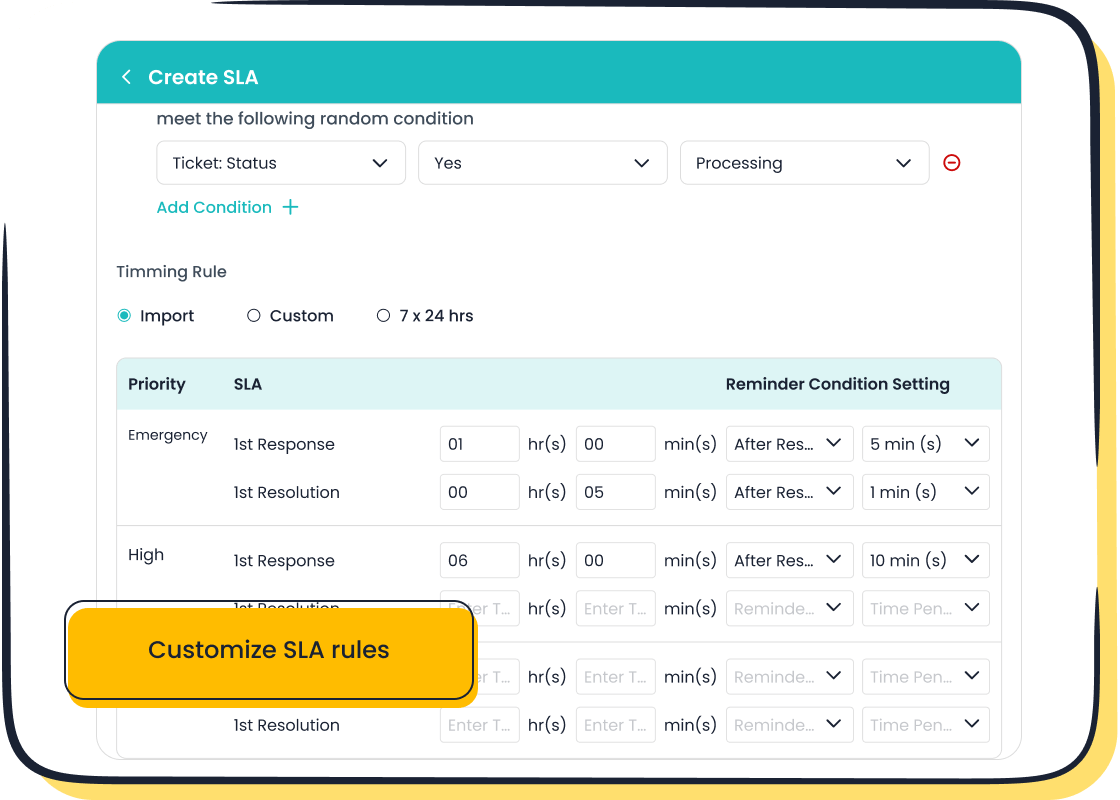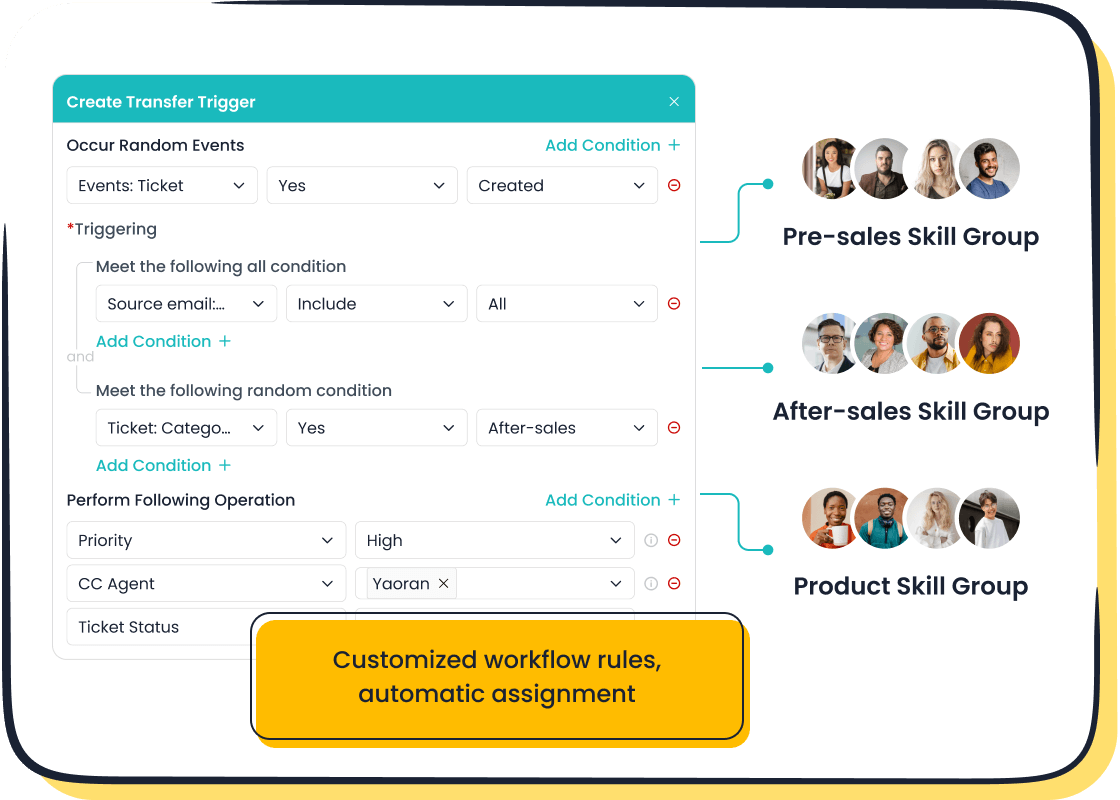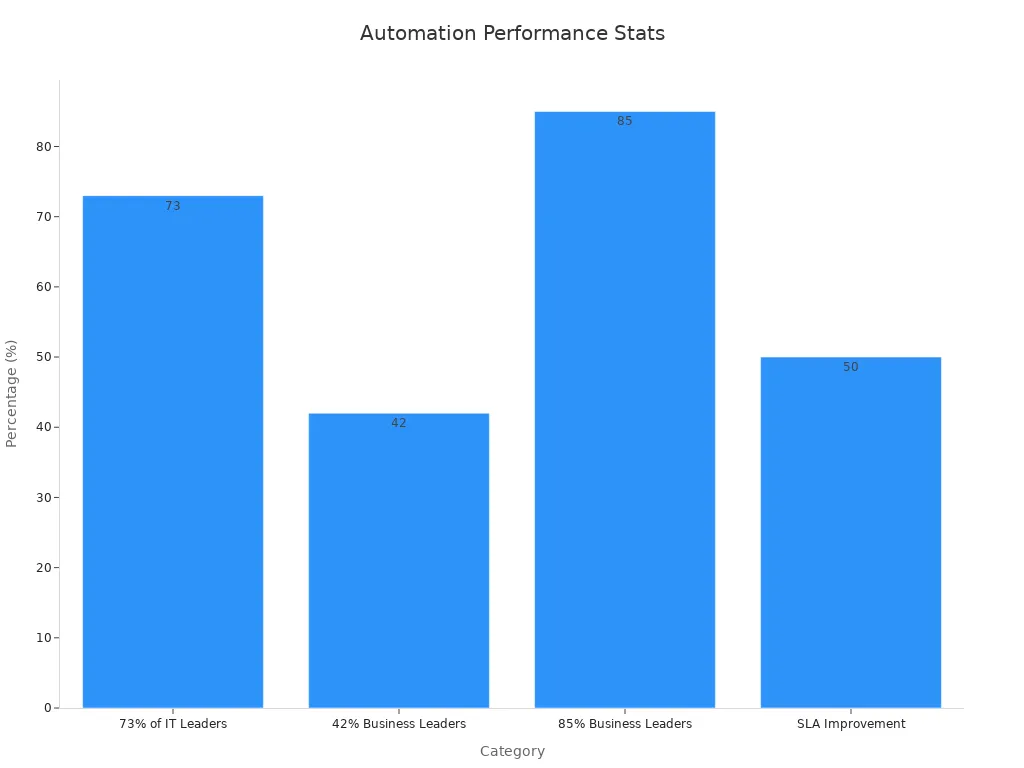Effortless Workflow Automation for Customer Service Teams

Automation has transformed customer service workflows, making them faster and more precise. Businesses now save up to 77% of time on routine tasks while reducing human errors by 32%. Automation also enhances data accuracy by 88%, helping teams deliver better service to customers. Customer service tracking systems play a vital role in this transformation. They simplify operations by centralizing data, improving response times, and enabling better documentation. Sobot’s Ticketing System takes this efficiency to the next level by automating ticket creation, routing, and resolution. With features like SLA management and multilingual support, it ensures seamless service for diverse customer needs.
Understanding Customer Service Automation
What is Customer Service Automation?
Customer service automation refers to the use of technology to handle routine tasks and respond to customer inquiries with minimal or no human involvement. This can include tools like chatbots, ticketing systems, and AI-powered platforms that streamline processes and improve efficiency. Automation allows you to resolve up to 70% of customer inquiries without human intervention, ensuring 24/7 support and immediate assistance. It also enables your team to focus on complex issues that require a personal touch.
The benefits of customer service automation are significant:
- Increased efficiency: Automation handles repetitive tasks, freeing up your team for more strategic work.
- Improved customer satisfaction: Faster resolutions lead to happier customers.
- Cost savings: Automated solutions reduce operational expenses by minimizing manual effort.
By adopting customer service automation, you can manage high volumes of inquiries seamlessly, even during peak times, while maintaining quality service.
The Role of Tracking Systems in Automating Workflows
A customer service tracking system is the backbone of effective workflow automation. It centralizes all customer interactions, ensuring that no inquiry slips through the cracks. These systems automate key processes, such as ticket creation, assignment, and resolution, which helps your team stay organized and responsive.
Tip: A well-implemented tracking system can reduce response times by up to 50%, significantly improving customer satisfaction.
Tracking systems also provide valuable insights through analytics. You can monitor performance, identify bottlenecks, and optimize workflows for better results. For example, tracking systems can categorize tickets by priority, ensuring that urgent issues are addressed first. They also support integration with other platforms, such as e-commerce tools, to create a seamless customer experience.
By using a customer service tracking system, you can ensure consistency, improve team collaboration, and enhance overall efficiency.

How Sobot’s Ticketing System Enhances Workflow Automation
Sobot’s Ticketing System takes workflow automation to the next level by combining advanced features with user-friendly design. It automates the management and resolution of customer requests, ensuring that every issue is tracked from initiation to resolution. This system promotes orderly teamwork and helps your team stay consistent and collaborative.
Here’s how Sobot’s Ticketing System enhances workflow automation:
- Unified platform: It integrates email, voicemail, and chat into a single system, eliminating the need to switch between tools.
- Automatic ticket routing: Tickets are assigned to the right agents based on custom triggers, saving time and reducing errors.
- SLA management: You can set response and resolution times to meet customer expectations.
- Multilingual support: The system handles inquiries in multiple languages, making it ideal for global businesses.
With features like trusted analytics and smart notifications, Sobot’s Ticketing System ensures that your team stays informed and efficient. It also supports integration with platforms like Shopify, enabling seamless workflows across your operations. By adopting this system, you can improve response times, reduce manual effort, and deliver exceptional service to your customers.
Benefits of Automating Customer Service Workflows

Faster Response Times and Improved Efficiency
Automation transforms your customer service workflows by speeding up response times and boosting efficiency. Automated workflows handle repetitive tasks, allowing your team to focus on strategic goals. For example, chatbots can instantly respond to common inquiries, ensuring customers receive immediate assistance. This reduces wait times and improves the overall experience.
Performance statistics highlight the impact of automation:
| Statistic | Description |
|---|---|
| 73% of IT Leaders | Believe automation saves about 50% of time spent on manual tasks. |
| 42% of Business Leaders | Agree that workflow automation saves time and allows focus on strategic tasks. |
| 85% of Business Leaders | Believe automation enables focus on important business goals. |
| SLA Improvement | Demonstrates a 50% reduction in case resolution time post-automation. |

By adopting workflow automation tools like Sobot’s Ticketing System, you can streamline operations and achieve faster resolutions. Features such as automatic ticket routing and SLA management ensure your team stays efficient and responsive.
Reducing Errors with Automated Processes
Automated customer service processes minimize human errors and improve accuracy. Automation adheres to standardized rules, ensuring consistent execution across workflows. Built-in validation checks identify issues early, leading to reliable outcomes. For instance, automated workflows ensure accurate ticket assignment and resolution, reducing the chances of miscommunication.
Key benefits of automation include:
- Automating repetitive tasks significantly reduces human errors.
- Systems follow precise rules, ensuring consistent and error-free operations.
- Validation checks help maintain accurate and up-to-date information, enhancing customer experiences.
Sobot’s Ticketing System exemplifies this by automating ticket creation and routing. Its intelligent tools, such as custom triggers and SLA reminders, ensure every ticket is handled correctly. This reduces errors and improves customer satisfaction.
Enhancing Customer Satisfaction Through Automation
Customer service automation enhances satisfaction by delivering faster and more reliable support. Automated workflows improve productivity, allowing your team to focus on complex issues. Chatbots provide 24/7 self-service options, ensuring customers receive assistance anytime. This boosts responsiveness and creates a positive experience.
Metrics demonstrate the benefits of automation:
- 63% reduction in average handle time improves efficiency.
- 40% increase in speed of answering customers enhances responsiveness.
- 60% increase in productivity leads to better service delivery.
Sobot’s Ticketing System contributes to these results by integrating multilingual support and trusted analytics. These features ensure your team delivers personalized and efficient service, fostering customer loyalty and satisfaction.
Optimizing Resource Allocation and Reducing Costs
Efficient resource allocation is crucial for maintaining a productive customer service team. Automation tools like Sobot’s Ticketing System help you achieve this by streamlining workflows and reducing operational costs. By automating repetitive tasks, such as ticket routing and resolution, you can free up your team to focus on more complex customer issues. This not only improves efficiency but also ensures that resources are used where they are needed most.
Here’s how automation optimizes resource allocation and reduces costs:
- Integrating data from various sources provides a clear view of your operations, enabling better decision-making.
- A unified platform allows seamless reallocation of resources between departments, improving flexibility.
- Advanced analytics help identify cost-saving opportunities, increasing efficiency by up to 25%.
Tip: Use automation to eliminate redundancies in your workflows. This reduces waste and enhances service delivery.
For example, Sobot’s Ticketing System consolidates all communication channels into one platform. This eliminates the need for multiple tools, saving both time and money. Its intelligent features, like SLA management and custom triggers, ensure that resources are allocated based on priority and urgency. Additionally, the system’s analytics provide insights into budget utilization, helping you avoid misallocation.
By adopting workflow automation, you can reduce operational costs while maintaining high-quality service. Businesses that streamline processes with tools like Sobot’s Ticketing System often see significant improvements in both efficiency and customer satisfaction. Start optimizing your resources today to achieve better results tomorrow.
Steps to Automate Customer Service Workflows
Identify Repetitive Tasks and Bottlenecks
The first step to automate customer service workflows is identifying repetitive tasks and bottlenecks. These are the areas where automation can have the most significant impact. Repetitive tasks often consume time and are prone to human error, slowing down your team’s efficiency. Examples include responding to common customer inquiries, ticket assignment, and updating customer records. Automating these tasks can save time and improve accuracy.
Bottlenecks, on the other hand, disrupt workflows and delay resolutions. They can arise from external factors like supplier delays or internal issues such as redundant approval processes. For instance, requiring multiple approvals for a single ticket can slow down the resolution process. Anticipating these bottlenecks and creating contingency plans can help minimize disruptions.
Tip: Start by listing all tasks your team performs daily. Identify which ones are repetitive or cause delays. This will give you a clear picture of where automation tools like Sobot’s Ticketing System can make a difference.
Map Out Current Workflows
Mapping out your current workflows is essential for understanding how your processes function and where improvements are needed. Use visual tools like SIPOC diagrams or Business Process Modeling Notation (BPMN) to break down each step of your workflow. For example, a SIPOC diagram can help you identify suppliers, inputs, processes, outputs, and customers involved in your service operations. This high-level view makes it easier to pinpoint inefficiencies.
| Technique | Description |
|---|---|
| SIPOC Diagrams | High-level process maps that visually represent a process, breaking it down into suppliers, inputs, processes, outputs, and customers. |
| Business Process Modeling Notation (BPMN) | A standardized language preferred by process experts for detailed process analysis and error fixing. |
| Data Flow Diagrams | Show how information flows within a process, linking data stores and external environments. |
| Unified Model Language (UML) | Specialized mapping tool for software building, categorized into behavioral and structural diagrams. |
By mapping your workflows, you can identify unnecessary steps, redundant approvals, or areas where automation can streamline operations. For instance, Sobot’s Ticketing System can automate ticket routing, eliminating the need for manual assignments and reducing delays.
Set Clear Automation Goals
Setting clear goals is crucial for successful customer service automation. These goals should be specific, measurable, and aligned with your business objectives. For example, you might aim to reduce ticket resolution time by 50% within six months or improve customer satisfaction scores by 20%. Defining these objectives helps you measure the success of your automation efforts.
| Goal Description | Specific Objective | KPI Example |
|---|---|---|
| Enhance operational efficiency | Reduce machine setup time by 30% in 6 months | Machine setup time |
| Streamline inventory management | Improve inventory turnover rate | Inventory turnover rate |
| Improve order processing | Decrease order processing time by 50% | Order processing time |
When setting goals, consider how automation tools like Sobot’s Ticketing System can help you achieve them. For instance, its SLA management feature ensures tickets are resolved within specified timeframes, directly contributing to faster resolutions and higher customer satisfaction. Clear goals not only guide your automation strategy but also provide benchmarks for evaluating its effectiveness.
Choose the Right Customer Service Tracking System
Selecting the right customer service tracking system is crucial for successful workflow automation. A good system acts as the backbone of your operations, ensuring every inquiry is tracked, prioritized, and resolved efficiently. When evaluating options, focus on features that align with your business needs.
Here are some key factors to consider:
- Integration Capabilities: Ensure the system integrates seamlessly with your existing tools, such as e-commerce platforms or CRM software.
- Automation Features: Look for systems that automate workflows, including ticket creation, routing, and resolution.
- Scalability: Choose a solution that grows with your business, accommodating increasing volumes of customer inquiries.
- User-Friendly Interface: A simple and intuitive design ensures your team can adopt the system quickly.
- Analytics and Reporting: Advanced analytics help you monitor performance and identify areas for improvement.
Sobot’s Ticketing System excels in all these areas. It integrates with platforms like Shopify, automates ticket routing using custom triggers, and provides multilingual support for global businesses. Its trusted analytics offer actionable insights, helping you optimize workflows and improve customer satisfaction. By choosing a robust system like Sobot’s, you can streamline operations and enhance your team’s efficiency.
Tip: Always test a system’s features with a trial period to ensure it meets your specific requirements.
Implement Automation Tools Like Sobot’s Ticketing System
Once you’ve chosen a tracking system, the next step is to implement automation tools that complement it. Tools like Sobot’s Ticketing System simplify complex workflows by automating repetitive tasks. This reduces manual effort and ensures faster resolutions.
Here’s how Sobot’s Ticketing System can help you automate customer service:
- Unified Communication: It consolidates email, voicemail, and chat into one platform, eliminating the need to switch between tools.
- Automatic Ticket Routing: Custom triggers assign tickets to the right agents, ensuring timely responses.
- SLA Management: You can set response and resolution times to meet customer expectations consistently.
- Multilingual Support: The system handles inquiries in multiple languages, making it ideal for businesses with a global presence.
For example, OPPO, a leading smart device company, used Sobot’s Ticketing System to handle a surge in customer inquiries during peak shopping periods. By automating ticket routing and integrating global communication channels, OPPO achieved an 83% chatbot resolution rate and a 94% positive feedback rate. This demonstrates how automation tools can transform customer service operations.
Note: Start small by automating one or two workflows. Gradually expand as your team becomes comfortable with the tools.
Monitor, Evaluate, and Optimize Automated Processes
Automation is not a one-time setup. To maximize its benefits, you need to monitor, evaluate, and optimize your workflows regularly. This ensures your system adapts to changing business needs and continues to deliver value.
Key metrics for evaluating automated processes include:
| Metric/KPI | Description |
|---|---|
| Number of Defects Found | Measures the number of issues discovered during testing. A high number can indicate thorough testing. |
| Defect Resolution Time | Tracks the average time it takes to fix identified defects. |
| Test Coverage | Measures the percentage of the codebase covered by test cases. A high percentage indicates comprehensive testing. |
| Defect Escape Rate | Measures the percentage of defects that go undetected during testing and surface in production. A low rate reflects effective testing. |
| Deployment Success Rate | Measures the percentage of deployments completed without requiring a rollback. A high rate indicates a reliable deployment process. |
| Mean Time to Resolution (MTTR) | Measures the average time taken to resolve production issues. A low MTTR indicates a swift response to problems. |
| Change Failure Rate | Measures the percentage of changes that lead to unforeseen issues in production. A low rate signifies a well-defined change management process. |
Regularly reviewing these metrics helps you identify bottlenecks and areas for improvement. For instance, if your defect resolution time is high, you may need to refine your workflows or provide additional training to your team.
Sobot’s Ticketing System simplifies this process with its trusted analytics and smart notifications. These features allow you to track performance in real-time and make data-driven decisions. By continuously optimizing your workflows, you can maintain high efficiency and deliver exceptional service to your customers.
Callout: Schedule monthly reviews of your automation metrics to ensure your system stays aligned with your business goals.
Overcoming Challenges in Customer Service Automation
Maintaining a Human Touch in Automated Interactions
Automation can streamline workflows, but maintaining a personal connection with customers remains essential. Customers value empathy and understanding, especially when dealing with complex issues. To balance efficiency and personalization, you can design chatbots to use natural language and provide personalized responses. For example, a chatbot that greets customers by name and remembers past interactions can create a more engaging experience.
Implementing sentiment analysis is another effective strategy. This technology detects customer frustration and escalates the issue to a human agent when necessary. Seamless transitions between automated systems and human representatives also ensure customers feel supported. For instance, Sobot’s Ticketing System integrates automation with human oversight, allowing agents to step in when needed.
"A blended AI approach where automation can help the human be more human is most ideal," says Graeme Provan, global director of business automation at Genesys.
By combining automation with human empathy, you can enhance customer satisfaction while maintaining efficiency.
Ensuring Data Accuracy and Security
Data accuracy and security are critical in automated customer service. Automated systems reduce human error by consistently following predefined rules. For instance, Sobot’s Ticketing System automates ticket creation and routing, ensuring accurate data handling. These systems also monitor compliance-related activities and generate real-time alerts for potential issues. This proactive approach helps you address risks swiftly and maintain trust with customers.
Proper evidence collection further strengthens data security. Automated tools organize compliance-related information, helping you identify gaps and mitigate risks. This not only ensures regulatory compliance but also protects your reputation. By prioritizing data accuracy and security, you can build a reliable foundation for your automated customer service operations.
Avoiding Over-Automation and Preserving Flexibility
Over-automation can lead to rigid processes and a lack of adaptability. While automation excels at handling repetitive tasks, it may struggle with unique or complex situations. To avoid this, you should empower your team with tools that complement automation. For example, Sobot’s Ticketing System provides analytics that helps agents make informed decisions, ensuring flexibility in customer interactions.
You can also set clear boundaries for automation. Use it to handle routine inquiries while reserving complex issues for human agents. Regularly reviewing your workflows ensures that automation supports, rather than replaces, human expertise. By maintaining this balance, you can preserve flexibility and deliver exceptional service.
Encouraging Team Adoption and Training
Adopting automation in customer service workflows requires your team’s full support. Training and clear communication play a vital role in ensuring a smooth transition. When employees understand the benefits of automation, they are more likely to embrace it.
Start by emphasizing how automation can enhance their skills and career prospects. For example:
- Training programs focused on automation tools provide employees with valuable expertise.
- AI-related job postings increased to 1.9% in 2022, showing a growing demand for automation skills.
- Highlighting career benefits motivates employees to engage with new technologies.
Creating a dedicated change management team also helps. This team can guide employees through the transition, address concerns, and collect feedback. Their involvement ensures smoother implementation and fosters a culture of collaboration.
Practical training sessions are essential. Tools like Sobot’s Ticketing System simplify workflows, but employees need hands-on experience to use them effectively. Demonstrate how features like automatic ticket routing and SLA management reduce manual tasks. Show how these tools free up time for more meaningful work.
Tip: Use real-life examples during training to illustrate how automation improves efficiency and customer satisfaction.
Regularly update your team on progress and celebrate milestones. Recognizing their efforts builds confidence and encourages further adoption. By investing in training and creating a supportive environment, you can ensure your team thrives in an automated workflow.
Real-World Applications and Success Stories

E-commerce Customer Support Automation
Automation has revolutionized customer support in e-commerce, enabling businesses to deliver faster and more personalized service. Companies like IKEA, Amazon, and Sephora have successfully implemented automated systems to enhance the customer experience.
- IKEA introduced a self-service portal that empowered customers to resolve issues independently. Over three years, this approach increased IKEA's eCommerce revenue share from 7% to 31%.
- Amazon uses predictive analytics to proactively notify customers about order statuses. This reduces inquiries and ensures smoother interactions.
- Sephora launched an AI-driven virtual assistant that attracted over 9,000 users in its first year. This innovation generated an average incremental monthly revenue of $30,000.
These examples highlight how automation can streamline operations and improve customer satisfaction. Tools like Sobot’s Ticketing System further enhance this process by integrating communication channels and automating ticket routing. This ensures inquiries are resolved efficiently, creating a seamless shopping experience for your customers.
Call Center Workflow Optimization
Call centers benefit significantly from automation, which improves efficiency and reduces operational costs. Automated systems ensure customers reach the right agent immediately, enhancing first-call resolutions. Agents gain instant access to customer history and AI-powered suggestions, reducing average handling time.
Businesses that adopt automation save an average of $0.70 per customer interaction. This cost reduction reflects increased efficiency across workflows. For example, Sobot’s Ticketing System consolidates customer data into a unified platform, enabling agents to respond faster and more accurately. Its SLA management feature ensures timely resolutions, further improving the customer experience.
By optimizing workflows, call centers can handle higher volumes of inquiries without compromising service quality. Automation tools like Sobot’s Ticketing System empower your team to deliver exceptional support while maintaining cost efficiency.
OPPO’s Success with Sobot’s Ticketing System
OPPO, a global leader in smart devices, transformed its customer service operations with Sobot’s Ticketing System. During peak shopping periods, OPPO faced a surge in inquiries that overwhelmed its human agents. By implementing Sobot’s automation tools, OPPO achieved remarkable results.
The system’s chatbot resolved 83% of inquiries, freeing agents to focus on complex issues. Positive feedback rates soared to 94%, while repurchase rates increased by 57%. Sobot also optimized OPPO’s knowledge base, reducing maintenance efforts by 90%. These improvements streamlined operations and enhanced the customer experience.
OPPO’s success demonstrates the power of automation in managing high-demand scenarios. With tools like Sobot’s Ticketing System, you can achieve similar results, ensuring your team delivers efficient and reliable service.
Customer service automation has become essential for businesses aiming to improve process speed and enhance customer satisfaction scores. By automating workflows, you can speed up customer service processes, reduce errors, and deliver consistent experiences. Tools like Sobot’s Ticketing System simplify operations with features such as SLA management, multilingual support, and chatbots, ensuring seamless integration across channels.
Automation benefits include faster response times, improved productivity, and enhanced customer experience automation. A self-service help desk powered by chatbots can further improve team productivity while reducing operational costs. Start small by automating repetitive workflows and gradually expand to custom workflow automation. This approach ensures scalability and long-term success.
| Benefit | Description |
|---|---|
| Enhanced Transparency | Provides visibility into task status, helping identify bottlenecks and roles. |
| Efficient Task Management | Manages multiple tasks simultaneously, improving collaboration and teamwork. |
| Improved Customer Experience | Enhances efficiency and personalization, leading to higher satisfaction. |
| Cost Efficiency | Reduces operational costs by automating routine tasks, allowing human agents to focus on complex issues. |
Take the first step toward transforming your workflows today. With Sobot’s Ticketing System, you can deliver exceptional experiences while optimizing resources effectively.
FAQ
What is workflow automation in customer service?
Workflow automation uses technology to streamline repetitive tasks like ticket routing and resolution. Tools like Sobot’s Ticketing System automate these processes, saving time and improving accuracy. For example, automated workflows reduce response times by up to 50%, enhancing customer satisfaction.
How does Sobot’s Ticketing System improve efficiency?
Sobot’s Ticketing System integrates communication channels, automates ticket routing, and provides SLA management. These features reduce manual effort and ensure faster resolutions. Businesses using Sobot report a 30% increase in productivity and a 94% positive feedback rate.
Can automation handle multilingual customer inquiries?
Yes, Sobot’s Ticketing System supports multiple languages, allowing customers to communicate in their preferred language. This feature is ideal for global businesses, ensuring seamless service across diverse regions.
How do I start automating my workflows?
Begin by identifying repetitive tasks and bottlenecks. Map your workflows and set clear goals. Choose a system like Sobot’s Ticketing System, which offers tools for automation, analytics, and integration. Start small and expand gradually.
Is automation secure for handling customer data?
Automation tools like Sobot’s Ticketing System prioritize data security. Features like compliance monitoring and real-time alerts ensure accuracy and protect sensitive information. Businesses can confidently manage customer data while adhering to regulations.
See Also
Understanding The Efficiency Of Call Center Automation
Enhancing Efficiency With AI Customer Service Solutions
Transforming Support With AI Customer Service Agents
